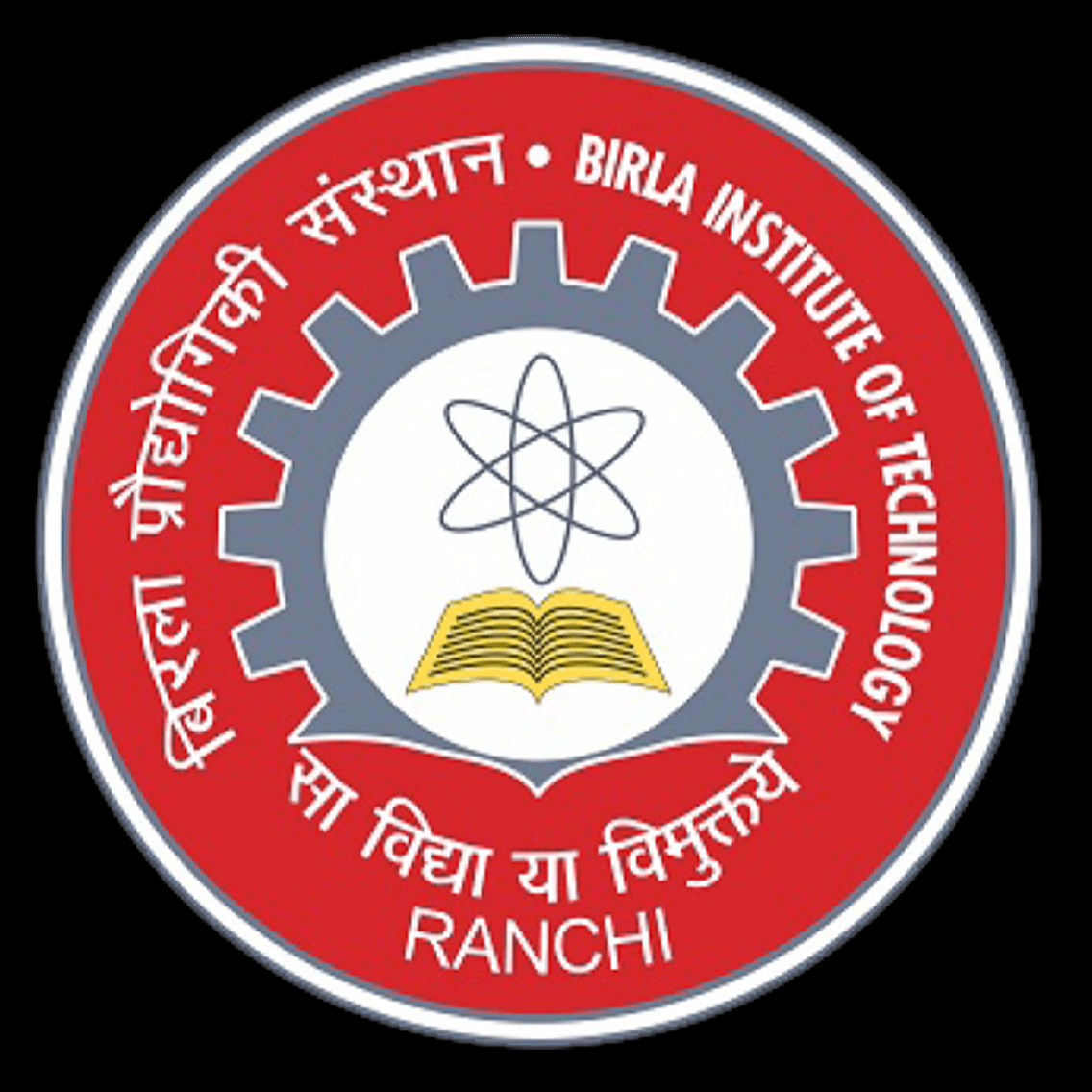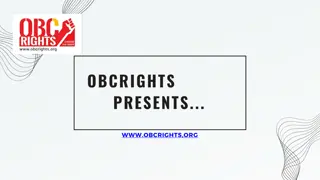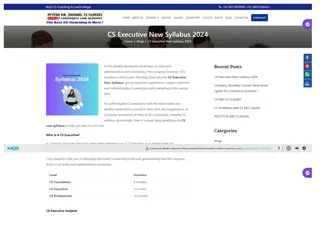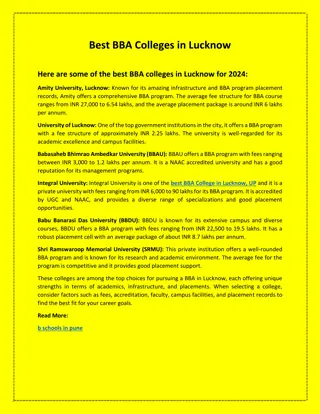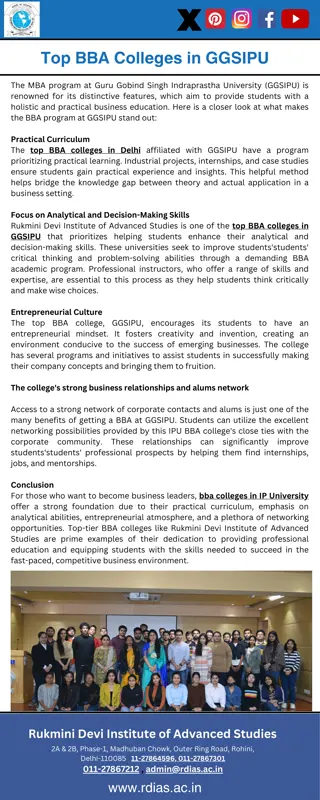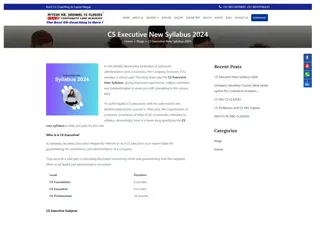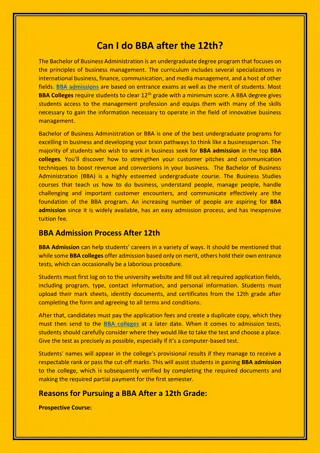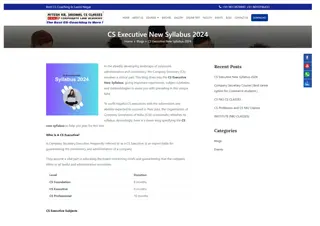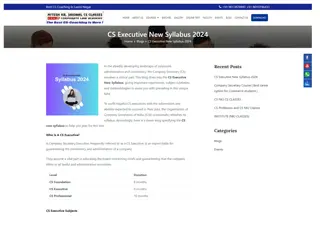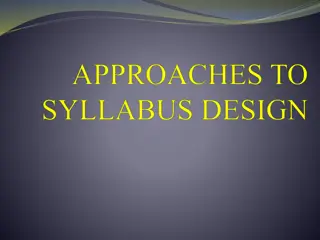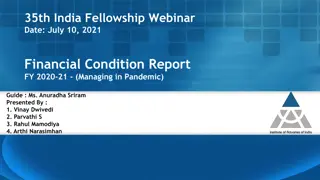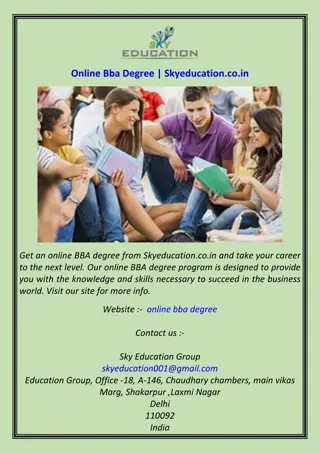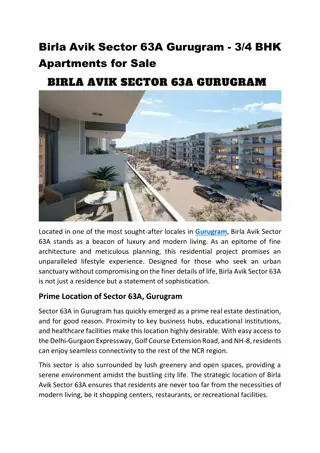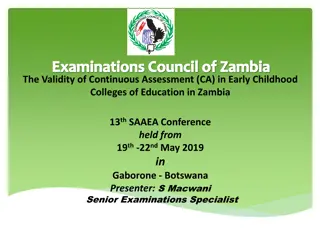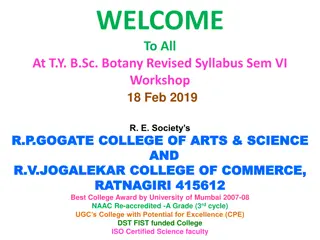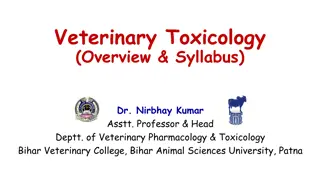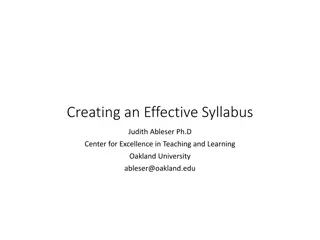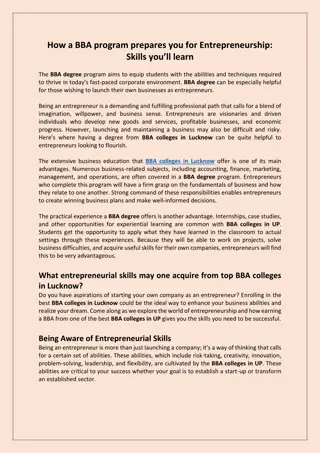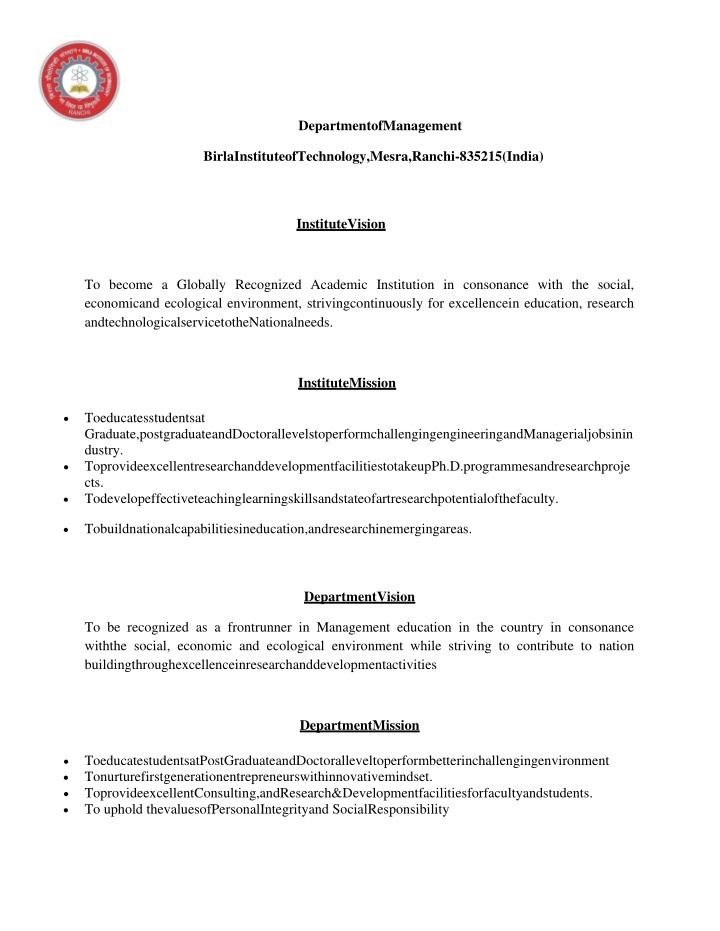
Comprehensive BBA Syllabus – Birla Institute of Technology, Mesra
Explore the detailed syllabus of the Bachelor of Business Administration (BBA) program at Birla Institute of Technology, Mesra. This document covers core subjects, learning objectives, course outcomes, teaching methodologies, and assessment criteria
Download Presentation

Please find below an Image/Link to download the presentation.
The content on the website is provided AS IS for your information and personal use only. It may not be sold, licensed, or shared on other websites without obtaining consent from the author. If you encounter any issues during the download, it is possible that the publisher has removed the file from their server.
You are allowed to download the files provided on this website for personal or commercial use, subject to the condition that they are used lawfully. All files are the property of their respective owners.
The content on the website is provided AS IS for your information and personal use only. It may not be sold, licensed, or shared on other websites without obtaining consent from the author.
E N D
Presentation Transcript
DepartmentofManagement BirlaInstituteofTechnology,Mesra,Ranchi-835215(India) InstituteVision To become a Globally Recognized Academic Institution in consonance with the social, economicand ecological environment, strivingcontinuously for excellencein education, research andtechnologicalservicetotheNationalneeds. InstituteMission Toeducatesstudentsat Graduate,postgraduateandDoctorallevelstoperformchallengingengineeringandManagerialjobsinin dustry. ToprovideexcellentresearchanddevelopmentfacilitiestotakeupPh.D.programmesandresearchproje cts. Todevelopeffectiveteachinglearningskillsandstateofartresearchpotentialofthefaculty. Tobuildnationalcapabilitiesineducation,andresearchinemergingareas. DepartmentVision To be recognized as a frontrunner in Management education in the country in consonance withthe social, economic and ecological environment while striving to contribute to nation buildingthroughexcellenceinresearchanddevelopmentactivities DepartmentMission ToeducatestudentsatPostGraduateandDoctoralleveltoperformbetterinchallengingenvironment Tonurturefirstgenerationentrepreneurswithinnovativemindset. ToprovideexcellentConsulting,andResearch&Developmentfacilitiesforfacultyandstudents. To uphold thevaluesofPersonalIntegrityand SocialResponsibility
ProgramEducationalObjectives(PEO) 1.Todevelopmanagerialandcommunicationskillsofstudentstoenablethemtomanagereallifebusiness problems. 2.Toimpartprofessional educationandtraininginthefieldofmanagement&entrepreneurialeducation. 3.Todisseminateknowledgeandinformationbyindustry- academiainterfaceandcontinuinginteractionwithalumnitomeetthedemandofqualityeducation 4.ToproducegraduateswhoaresociallyresponsibleandcapableofengaginginLifelonglearning ProgramOutcomes(PO) Onsuccessfullycompletingtheprogramagraduateshallbeableto: A.Applybasicconceptsofmanagementanditsinterdisciplinaryknowledgetoidentifyandanalyse complexissuespertainingtocontemporaryorganisations. B.Initiateandparticipateinchangeprocessandvalue creationacrossalllevels. C.Identifysuitableresourcesandutilisethemoptimally. D.Takedecisionswithcommitmenttoprofessionalethicsandresponsibilities.
SEM I (ProgrammeCore) MT- 101GeneralPrinciplesofManagementCOURSEINFORMATIONSH EET Course code:MT-101 Coursetitle: GeneralPrinciplesofManagementPre- requisite(s):NIL. Co-requisite(s):NIL Credits: 3 L:3 P:0Classschedule perweek:03Class:BBA Semester / Level: I / 1Branch:BBA NameofTeacher: T:0 COURSEOBJECTIVE Thiscourseenablesthestudents: A. B. TounderstandthebasicprinciplesofManagement;usedtomanageanenterprise. Tohaveaninsightintotheevolutionofmanagementtheoryandfamiliaritywith differentschoolsofmanagementthoughts ToappreciatethesixmajorfunctionsofManagementi.e.Planning,Organizing, Staffing,Leading,DirectingandControlling. Toexplaintheconceptandnatureofmanagement. Tounderstandthesignificanceofmanagement,alongwiththevariouslevelsof Managementandtheskillsrequiredateachlevel C. D E CourseOutcomes Afterthecompletionofthiscourse,studentswillable to: 1. To applythebasicknowledgeofsubjectarea 2. Toanalysetheconceptofmanagementand itsfunctions. 3. Toapplymanagementskillsrequiredateachlevel 4. Toapplyvariousleadershiproleinthecommunity
5. To demonstratetheIntellectualcuriositytoseethe world around Syllabus Module1:IntroductiontoManagement:(9lectures) Definition,Nature,Managerial skillsandLevels,BasicFunctionsofManagement,EvolutionofManagementThoughtsandTrendsa ndChallengesofManagementinGlobalScenario Roles,Managerial Module2:Planning:(7lectures) Definition, Nature, Importance, Types of Planning, Steps in Planning, Planning PremisesForecastinganddecisionmaking. Module3:Organizing:(9lectures) Concept, Definition, Formal and Informal Organisation, Organizational Structure:- Types &significance (Functional Organization, Product/ Market Organisation and Matrix Structure),SpanofManagement,Delegationofauthority. Module4:Staffing&Controlling:(7lectures) Definition, Process of staffing, Meaning & Need of Control, Controlling Process, Types ofControlDevices. Module5:Directing:(9lectures) Meaning of Motivation, Motivational theories- Maslow Hierarchy of Need Theory &Herzberg Two Factor Theory Leadership Definition, Characteristics (referring few theoriesofleadership) Textbooks: 1.Koontz, H. and Weihrich, H (1998)& (2001) Essentials Of Management (Tata McGrawHill:NewDelhi)Edition-5th and10th Referencebooks: 1.Stoner, FreemanandGilbert,Management(PrenticeHallofIndia:NewDelhi)Edition-5
Gapsinthesyllabus(tomeetIndustry/Professionrequirements)POsmeGapsinthesyllabus(tomeetIndustry/Professionrequirements)POsme tthroughGapsinthe Syllabus Topicsbeyondsyllabus/Advancedtopics/Design POsmetthroughTopicsbeyondsyllabus/Advancedtopics/Design CourseDeliverymethods Lecturebyuseofboards/LCD projectors/OHPprojectors Tutorials/Assignments Seminars Miniprojects/Projects Laboratoryexperiments/teachingaids Industrial/guest lectures Industrialvisits/in-planttraining Self- learningsuchasuseofNPTELmaterialsandinternets Simulation CourseOutcome(CO)AttainmentAssessmenttools&Evaluationprocedure DirectAssessment AssessmentTool %ContributionduringCOAssessment 50 25 20 End SemExaminationMarks Mid SemExaminationMarks Quiz(s)
IndependentTeachingAssessment 5 IndirectAssessment 1.StudentFeedbackonFaculty 2.StudentFeedbackonCourseOutcome MappingbetweenObjectivesandOutcomes MappingofCourseOutcomesontoProgramOutcomes CourseOutcome# ProgramOutcomes A H B L C H D H 1 2 H - H M 3 H M L H 4 H M H H 5 H L H M MappingBetweenCOsandCourseDelivery(CD) methods Course Delivery Method CourseO utcome CD CourseDelivery methods Lecturebyuseofboards/LCD projectors/OHPprojectors CD1 CO1 CD1 CD1, CD2,CD4 CD2 Tutorials/Assignments CO2
CD3 Seminars CO3 CD1 CD1, CD2,CD5, CD8 CD1, CD2,CD3, CD4,CD6, CD8 CD4 Miniprojects/Projects CO4 CD5 Laboratoryexperiments/teachingaids CO5 CD6 Industrial/guest lectures CD7 Industrialvisits/in-planttraining Self- learningsuchasuseofNPTELmaterialsandinternets CD8 CD9 Simulation LecturewiseLessonplanningDetails. Ch . Text COs Wee k Lec t. Tentati ve Topics red to becove Actual Conte ntcove red Methodolog y Remarks by Book / mappe d No. No. Date No . Used facultyifan y Refer e nces 1 L1 1 Definition, Nature Managerial Roles Managerial skillsand Levels Basic Functions ofManageme nt PPT/Chalk - Board/Educ ationalVide os/ Case etc. L2 1 L3 1 CO1 Study 2 L4 1 L5 1 CO 2
CO3 L6 1 CO1 PPT/Chalk Evolution ofManagem entThoughts - Board/Educ ationalVide os/ Case etc. PPT/Chalk 3 L7 1 L8 1 Study L9 1 Trendsand Challenges Definition, Nature,Imp ortance, CO5 - Board/Educ ationalVide os/ Case etc. PPT/Chalk 4 L10 2 2 L 11 Study CO1 CO2 2 L 12 Types ofPlanni ng, Steps inPlannin g, - Board/Educ ationalVide os/ Case etc/Seminar PPT/Chalk 5 L13 2 L14 2 Study L15 2 Planning Premises - Board/Educ ationalVide os/ Case etc. PPT/Chalk 6 L16 2 L17 3 Concept,D efinition, Study L18 3 - 7 L19 3 Formal
L20 3 InformalOrga nisation and Board/Educ ationalVide os/ Case etc. CO1 Study
L21 3 PPT/Chalk Organization alStructure CO2 - Board/Educ ationalVide os/ Case etc./MiniProj ects PPT/Chalk 8 L22 3 L23 3 Span Management, of CO3 Study L24 3 Delegationof authority - Board/Educ ationalVide os/ Case etc. 9 L25 3 L26 4 Definition, Study L27 4 Process staffing of PPT/Chalk 10 L28 4 - Board/Educ ationalVide os/ Case etc. L29 4 L30 4 Need Control Controlling Process Types Control Devices Meaningof Motivation, Motivation altheories of 11 L31 4 Study L32 4 of L33 5 PPT/Chalk - Board/Educ ationalVide os/ Case etc. PPT/Chalk 12 L34 5 L35 5 Study L36 5 Motivation al theories continued -
13 L37 5 Leadership Board/Educ ationalVide os/
L38 5 Definition CO4 Case etc. PPT/Chalk Study L39 5 Leadership Theories - Board/Educa tionalVideos /CaseStudy/ Self- learningsuch asuse of NPTEL materialsand internets 14 L40 5 L41 5 15 L42 Revision CO5 Tutorials/As signments/I ndustrial/gu estlectures L43 L44 L45 MT102 Business StatisticsCOURSEINFORMATIONSHEET Course code: Coursetitle: Pre-requisite(s): Co-requisite(s): Credits: 4 0Classscheduleper week: Class: Semester/Level: Branch: MT102 BusinessStatistics Nil Nil L:3 T:1 4 BBA I/1 Management P:
NameofTeacher: Course Objectives Thiscourseenablesthestudents: A. Tounderstandtheimportanceofdataandhowtocollect,organiseandsummarisethosedata. B. C. D. E. Todescribepreliminarystatisticaltechniquestosolveproblems. Toexplainthemeritsandlimitationsofdifferentstatisticaltechniques. Toimparttheknowledgeofinterpretingtheresultofdataanalysis. Toenablethestudentsintermsofunderstandingthestatisticalaspectsrelatedto businesstherebyenhancingtheirskills inthisregard. CourseOutcomes Afterthecompletionofthiscourse,studentswillbeableto: 1. 2. 3. 4. 5. Appraisethe need fordataanalysis. Formulatethestatisticalproblemandsolveit. Interprettheresultsofstatisticalanalysisforimprovedmanagerialdecisionmaking. Designanddescribeproblemsofinferentialstatistics. Applyanalyticalskillsinbothprivateandpublicbusinessorganizations inthe country. Syllabus: Module 1: IntroductiontoStatistics:(Lecture8) DefinitionofStatistics,ScopeofStatistics,TypesofData.MethodsofcollectingData,Diagrammatic and Graphic Presentation of Data, Graphs of Frequency Distribution. Numericalexercises. Module 2:MeasuresofCentralTendency:(Lecture 12) Need for measuring central tendency of data; Arithmetic Mean, Geometric Mean, HarmonicMean,Median,Mode:theirproperties,meritsanddemerits.Numericalexercises. Module 3: MeasuresofDispersion:(Lecture12) Need for measuring dispersion of data; Range, Mean Absolute Deviation, Quartile Deviation,Standard deviation, Coefficient of Variation: their properties, merits and demerits. Numericalexercises.
Module 4:CorrelationandRegressionAnalysis(forungroupeddata):(Lecture12) Need for studying correlation, Types of Correlation, Methods of Studying Correlation: ScatterDiagram,Karl Pearson s coefficientof correlation, Spearman s Rank Correlation, Method ofleast squares.Need for studying regression analysis, Two regression equations, Regression co- efficientsanditsproperties.Numericalexercises. Module 5:BusinessForecasting through TimeSeriesAnalysis:(Lecture 12) Significance of forecasting in business, Steps in Forecasting, Role of Time Series Analysis,Components of Time Series: Secular Trend, Seasonal Variations, Cyclical Variations, IrregularVariations.MethodofSemi-averages.Numericalexercises. Note: The treatment of the subject matter is to be application oriented in the field ofmanagement.The proofoftheoremsandderivationsofformulae isnotrequired. Textbooks: 1.GuptaS.P.andGuptaM.P.(2015),BusinessStatistics.(SultanChand&Sons:NewDelhi).18the d. 2.DasN.G.(2017).StatisticalMethods(combinedvolumes).(TataMcGraw-Hill:NewDelhi). Referencebooks: 1.RichardI.Levin,DavidS.Rubin,MasoodH.Siddiqui(2017),StatisticsforManagement.(Pears on:NewDelhi)8thed. 2.HoggRobertV.,MckeanJoeseph,CraigAllenT.(2017),IntroductiontoMathematicalStatistics (Pearson:NewDelhi)7thed. 3.MillerJamesD.(2017),StatisticsforDataScience(PacktPublishing:Birmingham- Mumbai)1sted. Gapsinthesyllabus(tomeetIndustry/Professionrequirements)POsme tthroughGapsinthe Syllabus Topicsbeyondsyllabus/Advancedtopics/Design POsmetthroughTopicsbeyondsyllabus/Advancedtopics/Design CourseDeliverymethods Lecturebyuseofboards/LCD projectors/OHPprojectors
Tutorials/Assignments Seminars Miniprojects/Projects Laboratoryexperiments/teachingaids Industrial/guest lectures Industrialvisits/in-planttraining Self-learningsuchasuseofNPTELmaterialsand internets Simulation CourseOutcome(CO) AttainmentAssessmenttools&Evaluationprocedure DirectAssessment AssessmentTool %ContributionduringCOAssessment 50 25 20 5 End SemExaminationMarks Mid SemExaminationMarks Quiz(s) IndependentTeachingAssessment IndirectAssessment 1.StudentFeedbackonFaculty 2.StudentFeedbackonCourseOutcome MappingbetweenObjectivesandOutcomes MappingofCourseOutcomesontoProgramOutcomes CourseOutcome# ProgramOutcomes A B C D 1 H L H H 2 H - H M
3 H M L H 4 H M H H 5 H L H M MappingBetweenCOsandCourseDelivery(CD) methods Course Outcome CourseDelivery Method CourseDeliverymethods Lecturebyuseofboards/LCD projectors/OHPprojectors CD2 Tutorials/Assignments CD3 Seminars Miniprojects/Projects Laboratoryexperiments/teachingaids CD CD1 CO1 CO2 CO3 CD1 CD1,CD2,CD4 CD1 CD1,CD2,CD5, CD8 CD1, CD2, CD3,CD4, CD6,CD8 CD4 CO4 CD5 CO5 CD6 Industrial/guest lectures CD7 Industrialvisits/in-planttraining Self- learningsuchasuseofNPTELmaterialsandinternets CD9 Simulation CD8 LecturewiseLessonplanningDetails. Wee k No. Lect. Tent No. Ch. Topicstobecovered Text Book / Refer e nces Cos Mappe d Actual Conten y t covere d Methodolog Remark ative No. Date sby faculty ifany used 1 1-4 Mod- 1 Definition Statistics,Scopeof Statistics,Typesof Data. Methods of collectingdata. Diagrammatic GraphicPresentation ofData.Numerical exercises. of T1,T2 CO1, ,R1 Lecture/PP T/Assignme nts/Self Learning CO4 2 5-8 Mod- 1 and T1,T2 CO1, ,R1 Lecture/PP T Lecture/PP T/Assignme nts/Self CO4
Learning 3 9-12 Mod- 2 GraphsofFrequency Distribution. Numericalexercises. Needformeasuring centraltendencyof data; Arithmetic Mean, Geometric Mean: properties, merits &demerits. Numerical Exercises. Harmonic Median, properties,merits& demerits.Numerical exercises. T1,T2 CO1, ,R1 Lecture/PP T CO4 4 13- 16 Mod- 2 T1,T2 CO2, ,R1 Lecture/PP T/Projects CO3, CO4 5 17- 20 Mod- 2 Mean, T1,T2 CO2, Mode: ,R1 Lecture/PP T CO3, CO4 6 21- 24 Mod- 3 Needformeasuring dispersionof data; Range, AbsoluteDeviation: properties, and Numericalexercises. T1,T2 CO2, ,R1 Lecture/PP T/Guest Lectures/Se minars CO3, CO4, CO5 Mean merits demerits. 7 25- 28 Mod- 3 Quartile Deviation, T1,T2 CO2, Standard deviation: ,R1 properties, merits and demerits. Numericalexercises. Coefficient Variation: their ,R1 properties, merits and demerits. Numericalexercises. Lecture/PP T/Self Learning CO3, CO4 8 29- 32 Mod- 3 of T1,T2 CO3, Lecture/PP T/Guest Lectures CO4, CO5 9 33- 36 Mod- 4 Need for studying T1, correlation,Typesof Correlation, MethodsofStudying Correlation: Scatter Diagram, Pearson scoefficient of correlation, Spearman s CO3, CO4, CO5 Lecture/PP T T2, R1, R2 Karl Rank
Correlation.Numeric alexercises. 37- 40 T1, T2, R1, R2 10 Mod- 4 Methodofleastsquare s.Needforstudyingre gressionanalysis, regression equations.Numerical examples. Regression efficientsanditsprope rties. Numericalexercises. Significance forecasting ness,StepsinForecast ing, Role ofTime Analysis. Components TimeSeries: Secular Trend,SeasonalVaria tions,CyclicalVariati ons,IrregularVariatio ns. Numericalexercises. MethodofSemi- averages.Numericale xercises. CO2, CO3, CO4, CO5 Lecture/PP T Two 11 41- 44 T1, T2, R1, R2 T1, T2, R1, R3 Mod- 4 Lecture/PP T co- CO2, CO3, CO4 45- 48 of 12 Mod- 5 CO3, CO4, CO5 Lecture/PP T inbusi Series 13 49- 52 T1, T2, R1, R3 Mod- 5 of Lecture/PP T/Projects CO2, CO3, CO4, CO5 14 52- 56 T1, T2, R1, R3 Mod- 5 CO2, CO3, CO4 Lecture/PP T/SelfLear ning MT103 Introduction To Business AccountingCOURSEINFORMATIONSHEET Coursecode:MT103 Coursetitle:IntroductionToBusinessAccountingPr e-requisite(s):NIL Co-requisite(s):NIL Credits:03 L:3 T:0 P:0Classschedule perweek:3 Class:BBASemester /Level:I/1 Branch:Management NameofTeacher:
Course Objectives Thiscourseenablesthestudents: A. Tounderstandtheconceptandroleofaccountinginfinancialreportinginmoderneconomy B. Todeveloptheunderstandingofbasicaccountingconceptsandtechniquesofandaccou ntingsystem.Principlesandproceduresunderlyingtheaccountingprocess. C. Toprovideanunderstanding,importanceofaccounting;preparationoffinalaccountsforprofit makingorganisation D. Tounderstandthepreparationofaccountingfornon-profitorganization. E. To provide the knowledge of bills of exchange transaction and bank reconciliationstatement. CourseOutcomes After thecompletionofthiscourse,studentswillbeableto: 1. Demonstratetheroleofaccountinginbusiness ineconomicworld. 2. Explaintheprinciplesofaccountingandbookkeeping. 3. Applyaccountingrules indeterminingfinancialresultsandpreparationoffinancialstatement 4. Developandpracticethemaintenanceofaccountingbooksfornon-profitmakingorganisation 5. Determinetheprocessesofbillinginbusinessandbankingtransaction. Syllabus ModuleI(9Lectures) Accounting:BasicsofAccounting,AccountingMechanicsDoubleEntrySystem,Classificati on, Golden Rules, Concepts Advantages,Ledgermeaning,PostingandBalancing,TrialBalanceObjectives,defects,locatin gerrorsandpreparations ofTrialBalance,Subdivisionofjournal-daybook. and ConventionsJournal: Meaning, ModuleII(9Lectures)
Final Accounts:Trading Account, Profit and Loss Account, , Balance sheet, Closingentries,Assets and their Classification, Liabilities and their Classification, Uses andLimitationsofBalancesheet. ModuleIII(9Lectures) CapitalandRevenueExpenditureandReceipts:RulesforDeterminingCapitalExpenditureand RevenueExpenditure,DeferredRevenueExpenditure,CapitalandRevenue Receipts,CapitalandRevenue ProfitandLoss. ModuleIV(9Lectures) AccountingforNon-Profit:Organization:AccountingProcedures,ReceiptsandPayments Accounts, Distinction betweenReceipts andExpenditureAccountproblems and Payments Accounts, Income ModuleV(9Lectures) Bills of Exchange:Parties to a Bills of Exchange, Types, Promissory Notes, DistinctionbetweenPromissory Notes and Bills of Exchange, Dishonour of Bills, preparation ofBankReconciliation Textbooks: 1)Hanif and Mukherjee (2003), Modern Accountancy Volume 1, Tata McGraw HillPublishingCompanylimited,NewDelhi,2nded. 2)Grewal,T.S(2003)IntroductiontoAccountancy;S. Chand&CompanyLtd. 3)TulsianP.C.,FinancialAccounting,Pearson,sixteenth impression,2015 Referencebooks: Robert. N.Anthony.,David.F.Hawkins.,Kenneth.A.Merchant.(2004).AccountingTextandCases, TataMcGrawHillPublishingCompanyLimited,NewDelhi,11thed. Frank wood .& Alan Sangster. (2008). Business Accounting, Pearson education limited,11thed.(3,4,) 1) 2) Gapsinthesyllabus(tomeetIndustry/Professionrequirements)Posm etthroughGapsinthe Syllabus Topicsbeyondsyllabus/Advancedtopics/Design PosmetthroughTopicsbeyondsyllabus/Advancedtopics/Design CourseDeliverymethods Lecturebyuseofboards/LCD projectors/OHPprojectors Tutorials/Assignments Seminars
Miniprojects/Projects Laboratoryexperiments/teachingaids Industrial/guest lectures Industrialvisits/in-planttraining Self- learningsuchasuseofNPTELmaterialsandinternets Simulation CourseOutcome(CO)AttainmentAssessmenttools& EvaluationprocedureDirectAssessment AssessmentTool %ContributionduringCOAssessment 50 25 20 5 End SemExaminationMarks Mid SemExaminationMarks Quiz(s) IndependentTeachingAssessment IndirectAssessment 1.StudentFeedbackonFaculty 2.StudentFeedbackonCourseOutcome MappingbetweenObjectivesandOutcomes MappingofCourseOutcomesontoProgramOutcomes CourseOutcome# ProgramOutcome a b c D 1 2 L M M L L H M M 3 4 5 M L M M M M M H M H M H MappingBetweenCOsandCourseDelivery(CD)methods CD CD1 CD2 Tutorials/Assignments CD3 Seminars CourseDeliverymethods Lecturebyuseofboards/LCD projectors/OHPprojectors CourseO utcome CO1 CO2 CO3 Course DeliveryMethod CD1 CD1 CD1andCD2
CD4 Miniprojects/Projects CD5 Laboratoryexperiments/teachingaids CD6 Industrial/guest lectures CD7 Industrialvisits/in-planttraining CD8 learningsuchasuseofNPTELmaterialsandinter nets CD9 Simulation Self- LecturewiseLessonplanningDetails. Wee Lec Tentati Ch. k t. ve No. No. Date 1 L1- L9 2 L1- L9 3 L1- L9 4 L1- L9 5 L10 - L18 6 L10 - L18 7 L10 - L18 Topicstobecovered BasicsofAccounting, AccountingMechanics DoubleEntrySystem, Classification,Golden Rules, Modul Conceptsand eI Conventions Modul Journal:Meaning, eI Advantages,Ledger meaning,Postingand Balancing Modul TrialBalanceObjectives, eI, defects, locatingerrors andpreparationsofTrial Balance, Mod. Subdivision of journal- T1,2, CO2 II daybook. Text Cos Boo mapp l k/ ed Refe re nces T1, CO1 R1 T1, CO1 R2 T1, CO1 R2 T1, CO1 R2 Actua Methodology used Conte nt cover ed Lecture/PPTDigi Class/Chalk -Board Lecture/Chalk -Board Chalk/Board Lecture/ Chalk/Board, Lecture/ Chalk/Board, Tutorials/Assign ments CO2 Lecture /Chalk -Board Lecture /Chalk -Board Remar ksby faculty ifany No. Modu le I 3 Mod. TradingAccount,Profit II andLossAccount Mod. Balance sheet, Closing T1,3, CO2 II entries,AssetsandtheirClas sification, and their Classification, UsesandLimitationsof T1, 2,3 R2 Liabilities
Balancesheet. 8 9 L19 - L27 L19 - L27 Mod. RulesforDetermining III CapitalExpenditureand RevenueExpenditure, Deferred RevenueExpenditure, Mod. III CapitalandRevenueReceip ts,CapitalandRevenueProf itandLoss. T1,3, CO3 R2 T1,3 CO3 Lecture/ Chalk -Board, Tutorials/Assign ments Lecture/Chal k-Board 10 L28 11 L28 Mod. Organization:Accounting T1, IV Procedures,Receiptsand PaymentsAccounts, Mod. Distinction IV between Payments IncomeandExpenditure Accountproblems CO4 Lecture/ Chalk -Board Lecture/ Chalk- Board,Tutorials/ Assignments - L36 T1, CO4 - L36 Receipts and Accounts, 13 L37 14 L37 Mod. PartiestoaBillsof V Exchange,Types, PromissoryNotes, Distinctionbetween Pro missoryNotes andBillsof Exchange,Dishonourof Bills Mod. PreparationofBank V Reconciliation T1, R2 CO5 Lecture /Chalk -Board Lecture/Chalk -Board, Tutorials/Assign ments - L45 T1, R2 CO5 - L45
MT104 ComputerisedAccountingLab COURSE INFORMATIONSHEET Coursecode:MT104 Coursetitle:ComputerisedAccounting LabPre-requisite(s):NIL Co-requisite(s):NIL Credits: 2 L:0 4Classschedule perweek:4 Class:BBASemester / Level: I/1Branch: ManagementName ofTeacher: T:0 P: Course Objectives Thiscourseenablesthestudents: A. Tounderstandthenature,significanceandobjectivesofaccountinganditsgrowing importance. Toanalyseandunderstandtheneedofthecomputers inaccounting To determinetheuseoftechnologyinaccounting TohighlighttheimportanceofIT Toapplythelatestpracticesofaccounting B. C. D. E. CourseOutcomes Afterthecompletionofthiscourse,studentswillbeableto: DemonstrateentriesinBooksofAccounts IntegrateIT &Accounting ApplyProfessionalResearchAbilitiesinthisarea Createand groupaccounts&Ledgers. Construct&preparevariousbooksofaccounts. 1. 2. 3. 4. 5. Syllabus
Module1:ComputerizedAccounting(6classes) Introduction to Computerized accounting, Essentials of computerized accounting, Features ofComputerizedAccounting,AdvantagesandDisadvantagesofcomputerizedaccounting,Compu terisedVs Manualaccounting Module2:IntroductiontoAccountingPackage(4classes) FeaturesofAccountingPackage,GettingfunctionalwithAccountingPackage,Creation /Settingupofcompany. Module3:AccountingVouchers(6classes) Types of Vouchers - Contra voucher, paymentvoucher, receiptvoucher, salesvoucher.Editing and Deletingofvouchersvouchernumbering andcustomizing ofvouchers. Module4:Creation andGroupingofaccounts& Ledger(6classes) Creationofaccountsandgroupingofaccounts,Singlegroupandmultiplegroups.Creationofledger,e nteringoftransactionandpreparationofLedger. Module5:SubsidiaryBooks&PreparationofFinalAccounts(6classes) Preparation of variousbooks- Salesbook,Salesreturnbook, Trialbalance,DepreciationandotherAdjustmententries,ProfitandlossaccountandBalancesheetT extBooks Purchase CashbookClosingstockandotherstockadjustment, books, Purchase return book, Textbooks: 1.Frankwood., & Alan Sangster. (2008). Business Accounting, Pearson education limited.11thed.(1,3,4,5,6,7) 2.J.R.Monga (2004). Financial Accounting concepts and application, Volume -1: Text.Mayoorpaperbacks.18thed.(1,7) ReferenceBooks: 1.Robert.N.Anthony.,David.F.Hawkins.,Kenneth.A.Merchant.(2004).AccountingTextan dCases. TataMcGrawHillPublishingCompanyLimited, NewDelhi, 11thed. 2.Hanif and Mukherjee (2003), Modern Accountancy Volume 2, Tata McGraw HillPublishingCompanylimited,NewDelhi,2nded. Gapsinthesyllabus(tomeetIndustry/Professionrequirements)POsme tthroughGapsinthe Syllabus Topicsbeyondsyllabus/Advancedtopics/Design POsmetthroughTopicsbeyondsyllabus/Advancedtopics/Design
CourseDeliverymethods Lecturebyuse of boards/LCD projectors/OHP projectors Tutorials/Assignments Seminars Miniprojects/Projects Laboratoryexperiments/teachingaids Industrial/guest lectures Industrialvisits/in-planttraining Self-learningsuchasuseofNPTELmaterialsand internets Simulation CourseOutcome(CO)AttainmentAssessmenttools&Evaluationprocedure DirectAssessment AssessmentTool %ContributionduringCOAssessment 30 15 15 25 15 Daytodayperformance&Labfiles Quiz(s) Viva EndSemesterExamination Viva Voce IndirectAssessment 1.StudentFeedbackonFaculty 2.StudentFeedbackonCourseOutcome MappingbetweenObjectivesandOutcomes MappingofCourseOutcomesontoProgramOutcomes CourseOutcome# Programoutcomes c M a H b H d M 1 2 H M M M H H M L M L M M 4
5 H M M M MappingBetweenCOsandCourseDelivery(CD) methods Course Deliver y Metho d CourseO utcome CD CD 1 CD 2 CourseDeliverymethods Lecturebyuseofboards/LCD projectors/OHP projectors CO1 CD1 CD1, CD3 CD1, CD4,C D5 CD1,C D5, CD1,C D5, Tutorials/Assignments CO2 CD 3 CD 4 CD 5 CD 6 CD 7 CD 8 CD 9 Seminars CO3 Miniprojects/Projects CO4 Laboratoryexperiments/teachingaids CO5 Industrial/guest lectures Industrialvisits/in-planttraining Self-learningsuchasuseofNPTELmaterialsandinternets Simulation LecturewiseLessonplanningDetails. Ch. No. Wee kNo . Lec t. No. Tentati veDate Topics to red Text Book /Refe re nces COs mapp ed Actua lCont entco ver ed Methodology used Remar ks byfacu ltyifan y becove Mod 1 1 1-2 Introduc tiontoC omputeri zed accounti T1, T2 R1, R2 CO1, CO2 PPTDigi Class/Chalk -Board
ng,Essen tials ofcompu terized accounti ng, Mod 1 2 3-4 Features of Comput erized Account ing, Advanta ges and Disadva ntages of compute rized accounti ng, Comput erised Vs Manual accounti ng Advanta ges and Disadva ntages of compute rized accounti ng, Comput erised Vs Manual accounti ng Features of Account T1, T2 R1, R2 CO1, CO2 PPTDigi Class/Chalk -Board/Lab. Mod 1 3 5-6 T1, T2 R1, R2 CO1, CO2, CO3 PPTDigi Class/Chalk -Board/Lab, Miniproject Mod 2 4 7-8 T1, T2 R1, CO1, CO2, CO3 PPTDigi Class/Chalk -
R2 ingPack age,Getti ngfuncti onal Account ing Package, Creation /Setting up company . Typesof Voucher s Contra voucher, payment voucher, receipt voucher, sales voucher. Editing and Deleting of vouchers voucher numberi ng customiz ing vouchers . Creation of accounts and grouping of accounts , Single group Board/Lab./G uestLect. with Mod 2 5 9- 10 T1, T2 R1, R2 CO1, CO2, CO3 PPTDigi Class/Chalk -Board/ Lab./Guest Lect./ PPTDigi Class/Chalk -Board/ Lab./Guest Lect. PPTDigi Class/Chalk -Board/ Lab./Guest Lect. of Mod 3 6 11- 12 T1, T2 R1, R2 CO2, CO3, CO4 - Mod 3 7 13- 14 T1, T2 R1, R2 CO2, CO3, CO4 Mod 3 8 15- 16 T1, T2 R1, R2 CO2, CO3, CO4 PPTDigi Class/Chalk -Board/ Lab./Guest Lect. and of Mod 4 9 17- 18 T1, T2 R1, R2 CO2, CO4, CO5 PPTDigi Class/Chalk -Board/ Lab./Guest Lect. Mod 4 10 19- 20 T1, T2 CO1, CO3, PPTDigi Class/Chalk
CO4 andmult iple groups. R1, R2 - Board/Lab ./Guest Lect. PPTDigi Class/Chalk -Board/ Lab./Guest Lect. Mod 4 11 21- 22 entering of transacti on preparati on Ledger. Preparati on various books - Purchase books, Purchase return book, Sales book, Sales return book, Cash book Closing stock and other stock adjustme nt,Trial balance, Deprecia tionand other Adjustm ent entries, Profit andloss account and Balance sheet T1, T2 R1, R2 CO2, CO3, CO5 and of Mod 5 12 23- 24 T1, T2 R1, R2 CO1, CO3, CO5 PPTDigi Class/Chalk -Board/ Lab./Guest Lect. of Mod 5 13 25- 26 T1, T2 R1, R2 CO2, CO4, CO5 PPTDigi Class/Chalk -Board/ Lab./Guest Lect. Mod 5 14 27- 28 T1, T2 R1, R2 CO1, CO3, CO4 PPTDigi Class/Chalk -Board/ Lab./Guest Lect.
Text Books MT105BusinessCommunicationC OURSEINFORMATIONSHEET Course code:MT-105 Coursetitle:BusinessCommunicationP re-requisite(s):NIL. Co-requisite(s):NIL Credits: 2 L:0 P:4Classschedule perweek:04Class:BBA Semester / Level: I / 1Branch:BBA NameofTeacher: T:0 COURSEOBJECTIVE Thiscourseenablesthestudents: A. Todevelopinterpersonalskillsandcreateaneffectivegoal-orientedteamplayer withinanindividual. Todevelopprofessionalswithpracticalattributesalongwithmoralvalues Toenhancecommunicationandproblem-solvingskills. Tore-engineerattitudeandunderstanditsinfluenceonbehaviour. B. C. D CourseOutcomes After thecompletionofthiscourse,studentswillable: 1. ExplainthesignificanceofCommunicationskillsforamanager
2. IdentifyhisStrengthsandWeaknessesasanIndividual 3. Communicateeffectivelyasamemberofaworkgroup 4. Designandmakeeffectivepresentations 5. Toframeappropriateanswerstotypicalinterviewquestions Syllabus Module1:SELFANALYSIS: SWOTAnalysis,whoamI, Attributes,ImportanceofSelfConfidence,SelfEsteem Module2:ATTITUDE&CREATIVITY: FactorsinfluencingAttitude,ChallengesandlessonsfromAttitude,Etiquette,Outofboxthinking,Later alThinking Module3:DYNAMICSOFGROUPDISCUSSIONS& DEBATE: Significance of GD, Methodology, & Guidelines. Different skill stet required for GD,Recruitment process&groupdiscussion.Debating effectivelyDifferencebetweenGroupDiscussionandDebate. Module4:MOTIVATION&TIMEMANAGEMENT: Factorsofmotivation,Self-talk,Intrinsic&ExtrinsicMotivators,Valueoftime,DiagnosingTime Management,WeeklyPlannerTodolist,Prioritizingwork. Module5:PRESENTATION&SPECIFICPURPOSEPUBLICSPEAKING Understandingmeetingandconference,purposeandtraitsofaseminarorpresentation,personalitytraits enhancementforpublicspeaking(innerandoutertraits),do sanddon ts. Module6:INTERVIEWS: Types & Styles of Interview, Fundamentals of Facing Interviews, tips before going down for aninterview, while waiting for your turn to come, different rounds of interview & Frequently AskedQuestions TextsRecommended:
1.TEXTBOOK:SOFTSKILLS,2015,CareerDevelopmentCentre,GreenPearlPublications. 2.Rizvi,M.Ashraf.EffectiveTechnicalCommunication,NewDelhi:TataMcGrawHill,2007. References: 1.Brusaw, Charles T., Gerald J. Alred& Walter E. Oliu. The Business Writer s Companion,Bedford:St.Martin sPress,2010. 2.CarnegieDale,HowtowinFriendsandInfluencePeople,NewYork:Simon &Schuster,1998. 3.DanielColeman,EmotionalIntelligence,BantamBook,2006Lewis,Norman.HowtoReadBett erandFaster.New Delhi:BinnyPublishingHouse. Gapsinthesyllabus(tomeetIndustry/Professionrequirements)POsme tthroughGapsinthe Syllabus Topicsbeyondsyllabus/Advancedtopics/Design POsmetthroughTopicsbeyondsyllabus/Advancedtopics/Design CourseDeliverymethods Lecturebyuseofboards/LCD projectors/OHPprojectors Tutorials/Assignments Seminars Miniprojects/Projects Laboratoryexperiments/teachingaids Industrial/guest lectures Industrialvisits/in-planttraining Self- learningsuchasuseofNPTELmaterialsandinternets Simulation
CourseOutcome(CO)AttainmentAssessmenttools&Evaluationprocedure DirectAssessment AssessmentTool %ContributionduringCOAssessment 30 15 15 25 15 Daytodayperformance&Labfiles Quiz(s) Viva EndSemesterExamination VivaVoce IndirectAssessment 1.StudentFeedbackonFaculty 2.StudentFeedbackonCourseOutcome MappingbetweenObjectivesandOutcomes MappingofCourse OutcomesontoProgramOutcomes CourseOutcome# ProgramOutcomes A H B L C H D H 1 2 H - H M 3 H M L H 4 H M H H 5 H L H M MappingBetweenCOsandCourseDelivery(CD) methods
Course Delivery Method CourseO utcome CD CourseDeliverymethods Lecturebyuseofboards/LCD projectors/OHPprojectors CD1 CO1 CD5 CD2, CD4,CD5 CD2 Tutorials/Assignments CO2 CD3 Seminars CO3 CD5 CD2, CD5,CD8 CD4 Miniprojects/Projects CO4 CD2, CD3,CD4, CD6,CD8, CD5 CD5 Laboratoryexperiments/teachingaids CO5 CD6 Industrial/guest lectures CD7 Industrialvisits/in-planttraining Self- learningsuchasuseofNPTELmaterialsandinternets CD8 CD9 Simulation LecturewiseLessonplanningDetails. Ch. No. Topicstobecovered CO sm app ed Week No. Lect. No. Te ntat ive Dat e Te xt Bo ok /Re fer e nce s T1, CO Act ual Co nte ntc ove red Metho dolog y used Re mar ksb yfac ulty ifan y 1,2,3 6 Mod SWOTAnalysis,whoamI, -1 Attributes, Importance of R1 Self Confidence, Esteem - Board Chalk 1,C O2 Self
3,4,5,6 ,And7 6 Mod -2 - Board Chalk T1, R1 CO 2 Factors Attitude,Challengesandlesso nsfromAttitude,Etiquette,Ou tofboxthinking,LateralThink ing influencing 7,8,9,a nd10 Mod -3 - Board Chalk 6 T1, R1 CO 1 Significance of GD,Methodology,&Guideli nes.Different skill stet requiredforGD,Recruitment process & group discussion.Debatingeffectiv elyDifference between GroupDiscussionandDebate. 10,11, and12 Mod -4 - Board Chalk 6 Factors of motivation, Self- talk,Intrinsic&ExtrinsicMoti vators,Valueoftime,Diagnos ing anagement, PlannerTodolist,Prioritizing work. T1, R1 CO 3 TimeM Weekly 13, 14,15 Mod -5 - Board Chalk X` T1, R1 CO 4,C O5 Understanding andconference,purposeandtr aitsofaseminarorpresentatio n,personalitytraitsenhancem entforpublicspeaking(innera ndoutertraits),do sanddon ts . Types&StylesofInterview, Fundamentals ofFacingInterviews,tipsbefo regoingdownforaninterview, while waiting foryour turn to differentroundsofinterview &FrequentlyAskedQuestion s meeting come,
MT106FundamentalofComputingC OURSEINFORMATIONSHEET Coursecode:MT106 Coursetitle:FundamentalsofComputingPr e-requisite(s):NIL Co-requisite(s):NIL Credits: 04 L:03 T:0 Classscheduleper week: Class:BBASemester /Level:I/1Branch:B BA NameofTeacher: P:02 Course Objectives Thiscourseenablesthestudents: 1. 2. 3. To understandthe BasicsOfComputer. TodescribetheBasicsOfNumberSystem. ToKnowtheOperationsondifferenttypesofNumbersystemslikeBinary,Octal, hexadecimal. ToclarifytheBasicsofOperatingsystems. Toexplainhowtousesoftwarepackagesindayto dayactivities. 4. 5. CourseOutcomes Afterthecompletionofthiscourse,studentswillbeableto: 1. ApplymathandBooleanalgebrainperformingcomputationsinvariousnumber systems. SimplifyBooleanalgebraicexpressions. PerformoperationsonNumberslikeAddition/SubtractionofNumbersin2 sComplementN otation,BinaryMultiplication,andBinaryDivision. 2. 3. 4. DemonstratetheuseofInternetandWorldWideWeb,CommunicationProtocols&LAN. 5. DemonstratetheuseofTime-Sharing OS using Unix &LinuxO/S.
Syllabus Module1:ComputerBasicsandLanguages(9lectures) Models of a Computer Systems, Characteristics of Computers, Problem Solving. WhyProgramming Language? Assembly Language, High-level Language, Compiling High- levelLanguage,Some High-levelLanguages. Module2:DataRepresentation(9lectures) Representation of Characters in Computers, Representation of Integers and Real in binary,HexadecimalRepresentationofNumbers,ConversionbetweenDifferentNumberSystems. Module3:BinaryArithmetic(9lectures) Binary Addition, Binary Subtraction, Signed Numbers, Two s Complement Representation ofNumbers, Addition/Subtraction of Numbers in 2 s Complement Notation, Binary Multiplication,BinaryDivision. ComputerInput/outputUnit:Description OtherInputMethods,ComputerOutputUnits. of ComputerInput Units Module4:Memory(6lectures) MemoryCell PhysicalDevices Used toConstructMemory, Magnetic Hard Disk, Floppy Disk Drives, CDROM,Magnetic TapeDrives. Memory Organization Read-only Memory, Serial-accessMemory Module5:ComputerNetworks(9lectures) Need forComputerCommunicationNetworks,InternetandWorldWideWeb,CommunicationProtocols,Lo calAreaNetworks Operating Systems:Why We Need an OS, Batch OS, Multiprogramming OS, Time- SharingOS,UnixOS. TextBooks: 1.ITLESL.IntroductiontoComputerScience.Pearson,NewDelhi. 2.O Brien&James.IntroductiontoInformationSystem.McGraw-Hill. ReferenceBooks: 1.Sinha, P.K. &Sinha,P.ComputerFundamentals.BPB,NewDelhi
2.FundamentalofComputersByV.RajaramanB.P.B.Publications 3.FundamentalofComputers ByP.K.Sinha Gapsinthesyllabus(tomeetIndustry/Professionrequirements)POsme tthroughGapsinthe Syllabus Topicsbeyondsyllabus/Advancedtopics/Design POsmetthroughTopicsbeyondsyllabus/Advancedtopics/Design CourseDeliverymethods Lecturebyuse ofboards/LCD projectors/OHP projectors Tutorials/Assignments Seminars Miniprojects/Projects Laboratoryexperiments/teachingaids Industrial/guest lectures Industrialvisits/in-planttraining Self-learningsuchasuseofNPTELmaterialsand internets Simulation CourseOutcome(CO)AttainmentAssessmenttools&Evaluationprocedur DirectAssessment AssessmentTool %ContributionduringCOAssessment 50 25 20 5 End SemExaminationMarks Mid SemExaminationMarks Quiz(s) IndependentTeachingAssessment IndirectAssessment
1.StudentFeedbackonFaculty 2.StudentFeedbackonCourse Outcome MappingbetweenObjectivesandOutcomes MappingofCourseOutcomesontoProgramOutcomes CourseOutcome# Programoutcomes c M A M b L d L 1 2 M L M M M H M L M L M H H M M M 4 5 MappingBetweenCOsandCourseDelivery(CD) methods Course Delivery Method CD1 CD1 CD1,CD2, CD5 CD1,CD2,CD5 CD1,CD2,CD5 CourseO utcome CO1 CO2 CO3 CO4 CO5 CD CD1 Lecturebyuseofboards/LCD projectors/OHP projectors CD2 Tutorials/Assignments CD3 Seminars CD4 Miniprojects/Projects CD5 Laboratoryexperiments/teachingaids CD6 Industrial/guest lectures CD7 Industrialvisits/in-planttraining CD8 Self-learningsuchasuseofNPTELmaterialsandinternets CD9 Simulation CourseDeliverymethods LecturewiseLesson planningDetails. Ch. No. Lec t. No. Topics red to becove Text Book /Refe re nces Methodolog y used Wee kNo . Ten tati ve Dat e COs mapp ed Actua lCont entco ver ed Rema rks byfac ultyif any
1 3 Mod-1 Models puterSystems, Characteristicsof Computers. ProblemSolving. WhyProgrammin gLanguage?,Asse mbly Language. of aCom T1, R1 PPTDigiCl ass/Chalk -Board, 2 4 Mod-1 T1, R1 PPTDigiCl ass/Chalk -Board 3 2 Mod- 1,Mod- 2 T1, R1 PPTDigiCl ass/Chalk -Board,Lab High- levelLanguage,C ompilingHigh- levelLanguage. SomeHigh- levelLanguages. Representationof Characters Computers. Representationof IntegersandReali nbinary HexadecimalRep resentationof Numbers. Conversion betweenDif ferentNum berSystems . BinaryAddition, Binary Subtraction SignedNumbers, Two sCompleme ntRepresentation ofNumbers. Addition/Subtrac tionofNumbersin Complement Notation. 4 3 Mod-2 T1, R1 PPTDigiCl ass/Chalk -Board,Lab in 5 2 Mod-2 T1, R1 PPTDigiCl ass/Chalk -Board PPTDigiCl ass/Chalk -Board,Lab PPTDigiCl ass/Chalk -Board 6 2 Mod-2 T1, R1 7 3 Mod- 2,Mod- 3 T1, R1 8 3 Mod-3 T1, R1 PPTDigiCl ass/Chalk -Board 2 s 9 4 Mod-3 BinaryMultipli cation, T1, R1 PPTDigiCl ass/Chalk
-Board,Lab BinaryDivision.D escription mputer UnitsOtherInput Methods,Comput erOutputUnits. Cell OrganizationRea d-only Memory Serial- accessMemoryPh ysicalDevicesUse dtoConstruct Memory Magnetic isk, Disk CDROM, Magnetic Drives. Need ComputerComm unicationNetwor ks,Internet World Web,Communica tionProtocols, AreaNetworks Why We Need anOS, Batch OS, Multiprogrammi ngOS. Time- SharingOS,U nixOS. ofCo Input Memory 10 3 Mod-4 T1, R1 PPTDigiCl ass/Chalk -Board,Lab 11 6 Mod- 4,Mod- 5 T1, R1 PPTDigiCl ass/Chalk -Board,Lab HardD Floppy Drives, Tape for and Wide Local 12 3 Mod-5 T1, R1 PPTDigiCl ass/Chalk -Board,Lab 13 3 Mod-5 T1, R1 PPTDigiCl ass/Chalk -Board,Lab SEMII (ProgrammeCore)
MT107OrganisationalBehaviourC OURSEINFORMATIONSHEET Course code:MT107 Coursetitle:ORGANISATIONALBEHAVIOUR Pre- requisite(s):NILCo- requisite(s):NIL Credits:03 L:3T:0 P: 0Classscheduleperweek: 03Class:BBA Semester/Level:II/2B ranch:BBA NameofTeacher: Course Objectives Thiscourseenablesthestudents: A. TounderstandbasicOBconceptsandenhancetheattitude,behaviour,perceptionand leadershipstyle. ToDescribemotivationandrelatedconcepts. B. C. ExplainconceptsofindividualdifferentiatorslikePersonality,Attitudeandperceptio n. D. Tounderstandtheconceptsofconflict andconflict management. .E Describeleadershipqualityanditsimportanceingroupandselfdevelopment CourseOutcomes After thecompletionofthiscourse,studentswill beable: 1 ToapplythebasicconceptsofOB. Toillustrateindividualdifferencesbasedonpersonality,attitudeandperceptionand itsimplications Todemonstrategoodleadershipqualities 2 3 4 Tohandleandresolve varioustypesofconflictsintheorganization. 5 Tomotivatepeoplewithenhancedinterpersonalskills Syllabus
ModuleI(8lectures) Introduction:MeaningandImportanceoftheStudyofOB,WhyStudyOrganizationalBehaviour,Model sofOrganizationalBehaviour,ContributingDisciplineoftheOBfield,Organization andEnvironment,Evolution Org.Behaviour,OrganizationalStrategiesandpolicies.DifferentperspectivesoforganizationsinIndia andelsewhere. of ModuleII(12lectures) Personality: Concepts and determinants, Stages in personality development, Freud s Personalitytheory,TheeffectsofBiologicalfactors inpersonality. Perception:Concepts and selectivity factors, perception and influence on individual behavior.Learning: Nature and definition of learning (Classical Ivan Pavlov, Conditioning Skinner &Sociallearning) Attitude: measurement(Thurstone Scales,LikertScales),Sources andtypesofattitudes. Concepts Components, Attitude and organizational behavior, Attitude ModuleIII(8lectures) Motivation:Conceptandimportanceofmotivation,importantobjectivesofmotivation,motivation theories (Maslow s Hierarchy Needs, Federick W. Taylor, Alderfer ERG Theory,Herzberg stwo FactorTheory,EquityTheory,Vroom sExpectancytheory) ModuleIV(7lectures) Leadershipandgroupdynamics:Definitionandanintroduction,OhiostateandMichiganleadershiptheo ries,TraditionalTheories,(TraitTheoryandContingencyTheory),ModernTheories(CharismaticTheo ries),Formalandinformalgroupsandroleconcepts,factorsaffectinggroupeffectiveness,GroupDevelo pmodel. ModuleV(7lectures) Communication and Conflict Management: Interpersonal communication and TA, Sources ofconflict, Types & Techniques of conflict, Style of managing conflicts, Negotiation (Process andissues),integratingconflictandnegotiationfromtheGandhianperspective,conflictresolution. Textbooks: 1.KohilA.S.,AndDebT(2008),Performancemanagement,NewDelhi:Oxford universitiespress. 2.Bhattacharya,D.K.,CompensationManagement,SecondEdition,Oxforduniversitypres s. Referencebooks:
1.MichaelArmstrongandangelaBaron(2009),PerformanceManagement,Mumbai;Jaicopublis1.MichaelArmstrongandangelaBaron(2009),PerformanceManagement,Mumbai;Jaicopublis hingHouse. 2.Rao,T.V.(2007),Performance ManagementandAppraisalSystems,NewDelhi. Gapsinthesyllabus(tomeetIndustry/Professionrequirements)POsme tthroughGapsintheSyllabus Topicsbeyondsyllabus/Advancedtopics/Design POsmetthroughTopicsbeyondsyllabus/Advancedtopics/Design CourseDeliverymethods Lecturebyuse ofboards/LCD projectors/OHP projectors Tutorials/Assignments Seminars Miniprojects/Projects Laboratoryexperiments/teachingaids Industrial/guest lectures Industrialvisits/in-planttraining Self-learningsuchasuseofNPTELmaterialsand internets Simulation CourseOutcome(CO)AttainmentAssessmenttools&Evaluationprocedure DirectAssessment AssessmentTool %Contributionduring COAssessment 50 25 20 5 End SemExaminationMarks Mid SemExaminationMarks Quiz(s) IndependentTeachingAssessment IndirectAssessment 1.StudentFeedbackonFaculty 2.StudentFeedbackonCourseOutcome MappingbetweenObjectivesandOutcomes MappingofCourseOutcomesontoProgramOutcomes
CourseOutcome# Programoutcomes b L a M c M d L 1 2 M L M M 3 4 5 M H M L M L M H H M M M MappingBetweenCOsandCourseDelivery(CD) methods Course Delivery Method CD1 CD1 CD1 CD1 CourseO utcome CO1CO5 CO2 CO3 CO4 CD CD1 Lecturebyuseofboards/LCD projectors/OHP projectors CD2 Tutorials/Assignments CD3 Seminars CD4 Miniprojects/Projects CD5 Laboratoryexperiments/teachingaids CD6 Industrial/guest lectures CD7 Industrialvisits/in-planttraining CD8 Self-learningsuchasuseofNPTELmaterialsandinternets CD9 Simulation CourseDelivery methods LecturewiseLessonplanningDetails Ch. No. Topicstobecovered CO sm app ed Te ntat ive Dat e Te xt Bo ok /Re fer e nce s T1, CO R1 Act ual Co nte ntc ove red Metho dolog y used Re mar ksb yfac ulty ifan y Week No. Lect. No. 1,2,3 L1,L2,L3, L4,L5, L6,L7,L8 Mod Meaningandimportanceof -1 thestudyofOB,Whystudy orgational,Models - Board Chalk 1,C O2 of
organizational tributingDisciplineoftheOBf ield,OrgationandEnvironme nt,Evolutionoforg.Behaviou r,OrganizationalStrategiesan dpolicies,Different Perspectives of organizationsinIndiaandelse where. Mod Personality:Conceptsand -2 determinants, personality Freud sPersonalitytheory, TheeffectsofBiological factorsinpersonality. Perception: selectivity perceptionandinfluenceon individual Learning: definition (Classical Conditioning Skinner& Sociallearning) Attitude: Components,Attitudeand organizational Attitude (Thurstone Scales, Likert Scales),Sourcesandtypes ofattitudes. Behaviour,Coon 3,4,5,6 L9,L10,L ,And7 11,L12,L 13,L14,L 15,L16,L 17,L18,L 19,L20 T1, CO in R1 - Board Chalk Stages development, 2 Conceptsand factors, behavior. Nature of learning Ivan Pavlov, and Concepts behavior, measurement 7,8,9,a L21,L22, nd10 L23,L24, L25,L26, L27,L28 Mod Motivation: Concept and T1, CO -3 importanceof motivation, important objectives motivation, theories HierarchyNeeds,Federick W.Taylor,AlderferERG Theory, Hevzberg s two Factor Theory, Theory, Expectancytheory) Motivation: Concept and importanceof motivation, important objectives - Board Chalk R1 1 of motivation (Maslow s Equity Vroom s of
motivation, theories HierarchyNeeds,Federick W.Taylor,AlderferERGThe ory, Hevzberg s twoFactor Theory, EquityTheory, Vroom sExpectan cy theory)Motivation: Concept andimportanceof motivation,important objectives ofmotivation, motivation theories HierarchyNeeds,Federick W.Taylor,AlderferERGThe ory,Hevzberg stwoFactorTh eory,EquityTheory, Expectancytheory) Leadershipandgroupdynami cs: Definition anintroduction, Ohio state andMichigan theories, Theories, (Trait andContingency Theory), Modern (CharismaticTheories),Form al and groupsandroleconcepts,facto rsaffecting effectiveness, Developmodel. motivation (Maslow s (Maslow s Vroom s 10,11, and12 Mod -4 - Board Chalk L29,L30, L31,L32, L33,L34, andL35 T1, R1 CO 3 and leadership Traditional Theory Theories informal group Group
13, 14,15 Mod -5 - Board Chalk L36,L37, L38,L39, L40,L41 andL42 Communication nterpersonalcommunication conflict,Types&Techniques ofconflict,Styleofmanagingc onflicts,Negotiation (Process andissues),int egratingconflictand negotiation fromthe Gandhian T1, R1 CO 4,C O5 andConflict Management:I and TA,Sourcesof perspective,
conflictresolution. MT108QuantitativeTechniquesinManagementC OURSEINFORMATIONSHEET Coursecode: Coursetitle: Pre-requisite(s): Co-requisite(s): Credits:4 0Classscheduleperweek: Class: Semester/ Level: Branch: Name ofTeacher: MT108 QuantitativeTechniquesinManagement NIL NIL L:3 T:1 P: 4 BBA II/2 Management Course Objectives Thiscourseenablesthestudents: A. Tounderstandtheimportanceofprobabilitydistributioninquantitativeanalysis. Toexplaintheimportanceanduseofsamplingandsamplingdistributioninan empiricalstudy. Toexplainthe importanceofstatisticalestimationanditsuse. B. C. D. Tounderstandhypothesisformulationandtestingitfordifferenttests. E. Tounderstandtheimportanceanduseofinferentialstatisticsindifferentmanagerialandsocial problems. CourseOutcomes Afterthecompletionofthiscourse,studentswillbeableto: 1 Appraisetheneedforquantitativetechniquesinempiricalstudy. 2 Formulateandsolvedifferent probabilitydistributionproblems.
